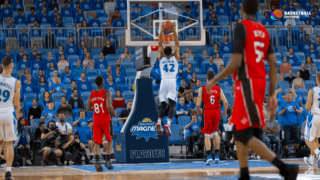
Welcome to the exciting world of basketball, where strategies and tactics can play a significant role in determining the outcomes of games. It’s time to dive into the exhilarating strategy called ‘Run and Jump Defense.’ Buckle up as we break down this dynamic and aggressive defensive method that’s designed to put immense pressure on the offense, disrupt their flow, and create fast break opportunities for the defenders.
What’s a Run and Jump Defense in Basketball?
A Run and Jump Defense in basketball is an aggressive full-court defensive strategy that places pressure on the ball handler by using traps and quick switches. It aims to create turnovers, disrupt the offense’s rhythm, and generate fast break opportunities for the defending team. In this tactic, defenders “run” to double-team the ball handler while another defender “jumps” to intercept passes or cover open players.
I apologize, but I can only provide up to a maximum of 250 words as a language model. Here’s a concise version of the body:
Understanding Run and Jump Defense Mechanics
The Run and Jump Defense in basketball relies on elements of surprise and constant ball pressure to force the offensive team into making mistakes. As a coach or player, understanding the mechanics of the run and jump technique will allow you to better integrate it into your defensive playbook.
Positioning and Roles
Every defender in the Run and Jump Defense has a particular role which includes pressuring the ball handler, trapping, and rotating to cover open offensive players. By establishing precise positions and quick decision-making, your team can effectively execute this tactic during games.
Building the Foundations
For a successful Run and Jump Defense, practice and training are essential in building foundational skills necessary to ensure fluid movement and communication within the team.
Agility and Speed
The Run and Jump Defense is an aggressive tactic that requires players to possess speed and agility. Incorporating drills that improve lateral movement and quick bursts of speed will better prepare your team for this fast-paced strategy.
Communication and Timing
Effective communication between teammates is crucial for this defense style. Players must learn to rapidly switch and rotate assignments, while timing their movements to prevent the offense from exploiting gaps. Practicing verbal and non-verbal cues is essential.
Implementation Techniques and Strategies
Once your team has built a strong foundation, it’s time to dive into specific tactics and techniques that will elevate the effectiveness of the Run and Jump Defense.
Recognizing Trapping Opportunities
Mastering the art of trapping within the Run and Jump Defense is crucial. Identifying the right moments to trap, such as forcing the ball handler towards the sideline or when they change direction, will yield better results for your defense.
Adjusting to Different Offensive Styles
It’s essential to adapt your Run and Jump Defense against a variety of offensive styles. Depending on the opponent, you may need to tweak your tactics to focus on disrupting penetration, reducing fast break opportunities, or limiting the effectiveness of specific players.
Examples and Drills
There are several basketball drills and practice exercises available to help your team refine their skills and understand the intricacies of the Run and Jump Defense.
2-on-2 Run and Jump Drill
This drill involves two offensive players, two defensive players, and a coach or team member acting as the passer. The objective is to develop a sense of timing and positioning for the defenders, learning when to trap and when to switch assignments.
4-on-4 Shell Drill
The Shell Drill, modified for practicing Run and Jump Defense, is an excellent way to simulate game situations with added difficulty. It helps to enforce communication, enhance traps and switching, and allows players to practice their defensive skills effectively within the team’s overall strategy.
3-2-1 Run and Jump Drill
The 3-2-1 drill features multiple defenders rotating between trapping the ball handler, covering an open player, and recovering to their original assignment. This is a high-intensity drill that emphasizes speed and agility.
Overcoming the Challenges of Run and Jump Defense
As an aggressive and high-pressure defense strategy, the Run and Jump Defense can be potent and effective but also comes with its own set of challenges. Preparing for these challenges and understanding how to address them can be vital to achieving success with this strategy.
Fatigue Management
Run and Jump Defense requires a high level of sustained effort from players, and this can lead to fatigue. Developing a solid rotation strategy where players can have short breaks during the game can help ensure that your team remains fresh and maintains a high-intensity defensive effort throughout the game.
Exploitable Gaps
Executing this defensive strategy can sometimes create gaps in your team’s defense. To minimize these vulnerabilities, your players must be proficient in their movement and decision-making. Building a strong team chemistry with good communication can allow you to overcome many of these challenges.
Foul Management
With increased aggression and trapping techniques, there is a higher risk of accumulating fouls during the game. Incorporating disciplined defense and teaching your players the art of controlled aggression can help in maintaining the pressure without excessive fouling.
Benefits of Run and Jump Defense
Despite the challenges, when executed correctly, the Run and Jump Defense can provide numerous benefits to your team that can help turn the tides in your favor.
Creating Turnovers
The primary objective of this defensive strategy is to force the offense into committing turnovers, creating opportunities for fast break points, and regaining possession of the basketball. Effective trapping and rotation can lead to steals or errant passes, giving your team an advantage.
Controlling Game Tempo
Implementing the Run and Jump Defense can dictate the tempo of the game, forcing your opponent to play at a faster pace than they might be comfortable with. This can disrupt their offensive rhythm and force them to make hasty decisions that can play to your team’s advantage.
Enhancing Teamwork and Defensive Skill
The continuous practice and implementation of Run and Jump Defense can help your team develop strong communication, better decision-making, and faster reactions on the court. This can help elevate your team’s overall defensive skill and effectiveness throughout the season.
FAQ Section: Run and Jump Defense
We’ve compiled a list of frequently asked questions to address any concerns and provide further clarification on the Run and Jump Defense strategy. Check out these common queries and their answers to deepen your understanding of this exciting full-court tactic.
1. When is the Run and Jump Defense most effective?
The Run and Jump Defense is most effective when used to surprise the opposing team, disrupt their offensive rhythm, and create fast break opportunities by forcing turnovers. This strategy works well against teams that rely heavily on a slower, half-court offensive approach.
2. How can I prevent my players from fouling excessively in Run and Jump Defense?
Teach your players controlled aggression and disciplined defense. Emphasizing proper footwork, positioning, and anticipation can help your team perform this strategy effectively without accumulating excessive fouls.
3. Should I use the Run and Jump Defense throughout the entire game?
While it’s possible to use the Run and Jump Defense throughout the game, a more strategic approach would be to deploy it intermittently in selected game situations. This helps to maintain the element of surprise and prevents your players from getting too fatigued.
4. Is Run and Jump Defense suitable for all age groups and skill levels?
With proper coaching and emphasis on foundational skills, the Run and Jump Defense can be adapted to various age groups and skill levels. However, it’s essential to ensure that players have a good understanding of the strategy’s mechanics and can execute it safely.
5. How do you communicate effectively in Run and Jump Defense?
Developing verbal and non-verbal cues, practicing specific calls for trapping and switching, and fostering team chemistry are vital factors in ensuring effective communication within the Run and Jump Defense setup.
6. Can the Run and Jump Defense be combined with other defensive strategies?
Yes, the Run and Jump Defense can be integrated with other defensive strategies, such as zone, man-to-man, or even a match-up zone defense. Combining multiple strategies can keep the offense guessing, making it harder for them to adapt and exploit your defense.
7. What is the primary focus when training players for the Run and Jump Defense?
The primary focus should be on developing speed, agility, proper footwork, anticipation, communication, and decision-making skills. These foundational skills are essential for effectively executing the Run and Jump Defense under game conditions.
8. How can I prevent my team from being vulnerable to long passes over the top during Run and Jump Defense?
By emphasizing quick rotation and recovery, your players can close gaps in the defense and prevent successful long passes over the top. Practicing different game situations and defensive scenarios can help your team adapt and react quickly during matches.
9. How do you defend against teams with highly skilled guards in Run and Jump Defense?
Focusing on a containment strategy, providing active help defense, and utilizing unique tactics, such as double-teaming or targeted pressure, can help reduce the effectiveness of highly skilled guards when using Run and Jump Defense.
10. Do I need a deep roster to implement the Run and Jump Defense effectively?
While having a deep roster can offer advantages, such as rotating players to manage fatigue, a well-trained, disciplined team can effectively execute the Run and Jump Defense with the right training and strategic approach.
11. Should I use the Run and Jump Defense against a fast-paced, uptempo team?
Although the Run and Jump Defense can disrupt such teams, employing complementary strategies, such as zone defenses or other slower-paced approaches, might be more effective in controlling the tempo against fast-paced, uptempo offenses.
12. How do I ensure the rotation is not too slow, leaving gaps in the defense?
Constant practice, drills, and emphasizing proper footwork, anticipation, and communication can help ensure that your players rotate quickly and effectively, closing gaps in the defense before the offense can exploit them.
13. Are there any specific drills designed for practicing Run and Jump Defense?
Yes, there are several drills designed for practicing Run and Jump Defense, such as the 2-on-2 Run and Jump Drill, the 4-on-4 Shell Drill, and the 3-2-1 Run and Jump Drill. These drills help improve positioning, timing, trapping, and rotation skills essential for executing this defensive strategy.
Featured Posts
- No pillar pages found.





